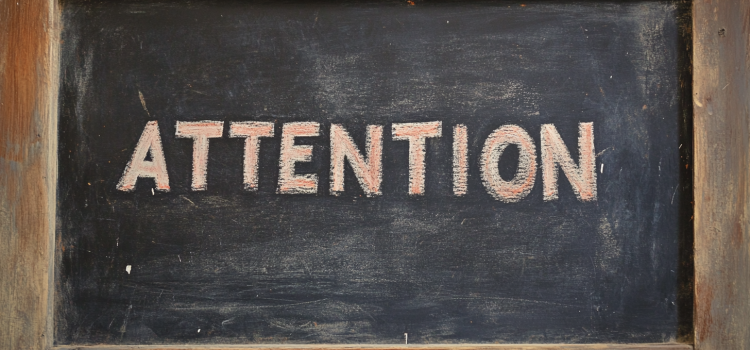
What does attention mean? What’s the difference between executive and automatic attention?
In Attention Span, Gloria Mark argues that defining attention isn’t as easy as it sounds—since we use the word “attention” as an umbrella term for a variety of cognitive behaviors. Mark starts from the traditional definition of attention and expands it to include automatic and dynamic factors that affect where your mind directs its focus.
Keep reading if you want to learn more about the complex meaning of attention.
The Nature of Attention
What does attention mean in psychological terms? Psychologists have long described attention as something you do deliberately. In other words, attention is your choice to concentrate on a single task or experience at any given moment. However, Mark explains that in practice, attention is much more complicated. While you can direct some of your attention by choice, much of your attention is out of your conscious control. Mark differentiates between executive attention, in which your brain prioritizes tasks and decides where to place your focus, and automatic attention, in which your instincts and habitual responses reroute your focus faster than you can stop them.
(Shortform note: Mark’s distinction between “executive” and “automatic” isn’t the only way to think about attention. In Focus, psychologist Daniel Goleman describes two mental states, open awareness and selective attention. Open awareness is a form of fluid, passive attention in which you’re not focused on one specific task; this state corresponds with the kind of mental downtime Mark espouses (which we’ll cover later). In contrast, selective attention is the effortful focus you use to filter sensory stimuli and narrow your attention on what’s relevant. As the name suggests, selective attention helps your brain choose where you direct your attention, but as Mark points out, your mind can engage it consciously or unconsciously.)
Mark suggests that automatic attention is an evolutionary survival trait. For instance, while your ancient ancestors were gathering berries in the woods, the sound of a growling predator would immediately redirect their attention from their previous task to the unexpected threat. This instinct still serves you today: When you’re talking on your phone while crossing the street, your instincts redirect your focus to the sound of a car horn. However, Mark explains that these same survival instincts override your attention for any trigger you’re habituated to respond to, such as text message notifications or phone calls. As a result, your automatic attention-switching instincts make resisting distractions especially difficult.
(Shortform note: The instinctive attention-switching Mark writes about is hard to overcome because it’s built into the brain’s fundamental architecture. In A Thousand Brains, neuroscientist Jeff Hawkins explains that the human brain has two major regions—the neocortex and the Old Brain; the latter is similar to that of many animal species. All sensory signals and motor commands pass through the Old Brain before reaching the neocortex, where our higher cognitive functions reside. Therefore, any surprising input, such as a notification, a car horn, or the growl of a wolf, prompts the Old Brain to switch your attention immediately, before your neocortex is even notified of the input.)
Dynamic Attention
Much of the literature on attention describes ways to avoid distractions and maintain focus. However, Mark argues that the environment needed for focused attention can only exist in laboratory settings, especially given the number of digital devices and media platforms we interact with daily. In the real world, your attention is dynamic, switching from task to task and stimuli to stimuli. The constant rerouting of your attention can lead to stress, fatigue, and burnout as you steadily drain your mental reserves, but it’s also a fact of modern life that any attempt to optimize concentration must take into account.
(Shortform note: Whether conscious or not, attention-switching burdens us with decisions. In The Organized Mind, Daniel J. Levitin argues that when you’re bombarded by information, as we all are in the digital world, you have to constantly decide what to pay attention to, which can be exhausting even if most decisions are trivial—such as whether to read an email now or later. Levitin explains that your brain can only make a limited number of decisions per day, it doesn’t distinguish between their importance, and it spends the same amount of energy on each one. This leads to decision fatigue, which may not sap your attention but hampers how much you can control it.)
The Four Modes of Attention
Before we go into how to improve your ability to focus and the challenges you’ll face in doing so, we’ll show how Mark explains the different types of attention and the internal factors that shape them. We’ll also see that these modes of attention wax and wane over time, and that instead of fighting against certain types of focus, your goal should be to balance them to sustain your cognitive reserves.
Productivity experts talk about focus as an “all or nothing” condition—you’re either paying uninterrupted attention, or you’re not. However, Mark insists that this is an oversimplification. Her research shows that we experience four distinct modes of attention—concentration, mechanical attention, apathy, and irritation. Which state you’re in is determined by how difficult and engrossing what you’re doing is.
1. Concentration: Mark says we’re most able to focus our attention when what we’re doing is both difficult and engrossing, such as editing a novel, designing a business plan, coding a new piece of software, or distilling reams of data into a presentation.
2. Mechanical: Mark describes mechanical attention as the mental state that occurs when what we’re doing is engrossing but easy, as when doing routine work such as data entry, collating files, or checking inventory. This attention state also occurs when performing “mindless” activities like checking social media or rewatching your favorite movies.
3. Apathy: This occurs when what you’re doing is neither difficult nor engrossing, such as sitting through an endless presentation. It also includes “idle time” in which there isn’t pressing work to do at all.
4. Irritation: Mark’s fourth attention category occurs when what you’re doing is difficult but not engrossing, such as trying to clear a paper jam from a copier.
The Power of Routine
The big difference between Mark’s views on attention and those of traditional productivity experts is her emphasis on the value of mechanical attention. Her research shows that routine tasks requiring only mechanical attention are key to bolstering your mental reserves and, by extension, your productivity. Mark says that mechanical attention relieves stress and provides quicker rewards than tasks requiring intense concentration, and also that doing routine work makes more challenging tasks easier to tackle.
The conventional wisdom among productivity experts is that people are happiest and most productive if they can achieve the deep immersion state of focused attention, commonly referred to as “flow.” However, Mark’s research seems to contradict this: She found that people are most content when performing routine, undemanding tasks like digitizing documents, scrolling through the news, or cooking a recipe they know by heart. Mark points out that focused concentration on a challenging task, such as writing a grant or crafting a presentation, is correlated with higher levels of stress. Also, routine work uses up less mental energy and provides quicker—if less significant—rewards.






